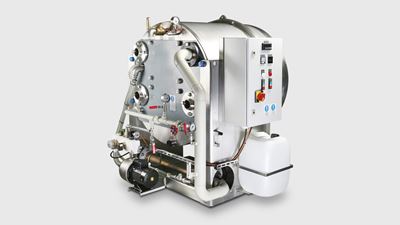Overview
SeaWaterDistiller
The SeaWaterDistiller is working on the well-known vacuum distillation principle. Waste heat from the main engine on board is utilized as heating medium for evaporation. The evaporation takes place in the evaporation plate bundle located in the lower part of the housing. A part of the incoming sea water evaporates due to the high vacuum inside the housing. The generated vapor is cleaned from sea water droplets while flowing through a wire mesh demister.

Generation of fresh water from sea water
The condensation takes place in the condenser plate bundle located in the upper part of the housing. The condenser is cooled by sea water. The latent heat from condensation is transferred to the sea water. The condensation / evaporation temperature varies with the sea water temperature. A small portion of the heated sea water is utilized as feed water for the evaporator bundle. The biggest part is used as driving medium for the combined air- / brine ejector.
This ejector has a double function: Extraction of the surplus sea water (so-called brine) out of the housing and vacuum creation by exhaust of the non-condensable gases. The distillate quality (salinity) is monitored at the control panel. If the salinity exceeds the adjusted set point (2 – 10 ppm) the distillate is rejected back to the evaporator via a solenoid valve.
Features:
- Simple, compact design
- Distillate pump, control panel, chemical dosing equipment
- Titanium heat exchanger plates
- Sea water resistant materials
- Hinged hood
Optional supply
- Sea water pump (necessary for operation)
- Re-hardening filter (pH-adjustment)
- UV-Sterilizer
Heating modules for various heat sources e.g.
- Steam
- Hot water
- Thermal oil
Standard equipment
- Control panel (built in on left or right side)
- Chemical dosing tank (built in)
- Distillate pump
- Set of thermometers and pressure gauges
- Set of non-return flaps
- Feed water valve
- Solenoid valve
- Water meter
- Salinity measuring cell + indicator
Downloads
GEA Insights India
All pharmaceutical freeze-drying vials are the same! Aren't they?
Whether it’s a fad or the future, 100% vial traceability is becoming an increasingly important consideration in the pharmaceutical freeze drying industry. Keeping a close eye on developments is GEA. We’re investigating possible solutions and, what’s more, we have the experience, expertise and know-how to implement them.
Alcohol-free beer: They want it all – they want less
There was a time when the phrases ‘non-alcoholic beer’ and ‘tastes good’ were seldom used together in the same sentence, particularly by consumers. But low-proof and alcohol-free beers have come a long way – many of them now refreshing drinks in their own right – thanks in no small part to technology from GEA.
Innovating patient care with aseptic spray drying
At GEA, our commitment to engineering for a better world fuels our pursuit of innovative solutions that enhance patient care and safety. One of our most promising ventures in recent years is aseptic spray drying – a technology that promises to revolutionize pharmaceutical manufacturing.